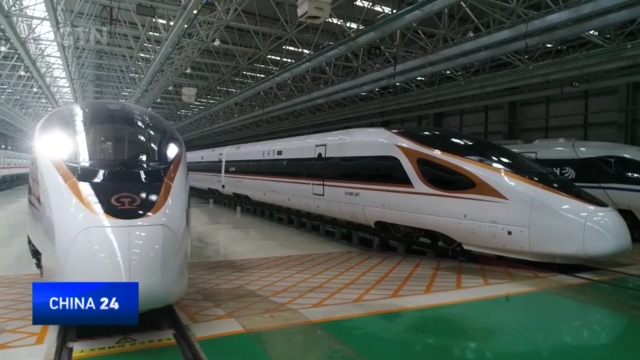
21:03, 20-Dec-2018
Breakthroughs in HSR Technologies: China’s high-speed railways aim for even faster travel times
Updated
20:44, 23-Dec-2018
03:16

China's high-speed train network has drastically cut journey times for its residents. And now traveling across the country may get even faster. Aiming for speeds of 400 kilometers per hour, the railway network could be on the brink of an exciting new era. But what safety measures and other hurdles do the experts need to clear? CGTN's Omar Khan reports.
What began as research and development 25 years ago has put China on top of the high-speed railway world. By the end of 2017, China's HSR mileage exceeded 25,000 kilometers nationwide, giving it two-thirds of the global total. Both the construction and operation scale now rank first worldwide. However, experts say reaching these heights was not easy.
ZHAO WEIHONG, PRINCIPAL RESEARCHER CHINA ACADEMY OF RAILWAY SCIENCES "In the beginning, some trains were not suitable for China's requirements and operational environment, so we had to do a lot of technical analysis. Our Harmony trains encountered many difficulties during the application process, such as if one train had an issue, whether other trains could rescue it. Based on all these challenges, we decided we must develop our own brand with our independent intellectual property rights, like the Fu Xing EMU train."
Currently, over 5,000 high-speed trains run daily across China, transporting more than 5 million passengers in less than half the travel time as before.
From 2007 to last year, China's railway passenger volume increased by 127.3 percent. Officials say the nation's reform and opening up laid the foundation for China's HSR technology innovation and large-scale railway construction.
QI YANHUI, DEPUTY DIRECTOR DEPARTMENT OF SCIENCE AND INFORMATION TECHNOLOGY, CHINA RAILWAY "The reform and opening up helped rapidly develop China's urban and rural economies, and people's living standards. Also, people now have more desire to travel, to see our beautiful landscapes. The original railway system could not meet travel demands or requirements. This promoted the development of our high-speed railway technology and network construction."
Officials say China will continue to pursue HSR technology and speed up EMU trains in the future.
QI YANHUI, DEPUTY DIRECTOR DEPARTMENT OF SCIENCE AND INFORMATION TECHNOLOGY, CHINA RAILWAY "We are working on technology innovation, experimental verification, and the safety concerns of speeds as high as 400 kilometers an hour. We will provide a timeframe for development, after getting a comprehensive demonstration of the needs of the national economy, the people, the safety test verification."
ZHAO WEIHONG, PRINCIPAL RESEARCHER CHINA ACADEMY OF RAILWAY SCIENCES "In the future, we will focus more on different speed levels and green intelligence. We use intelligent technology on the Beijing-Zhangjiakou Intercity Railway and Beijing-Xiong'an high-speed railway."
China's rapid development pace, large-scale construction, and huge transport capacity have it setting lofty goals for the future of its high-speed railway network.
Omar Khan, CGTN, BEIJING.

SITEMAP
Copyright © 2018 CGTN. Beijing ICP prepared NO.16065310-3
Copyright © 2018 CGTN. Beijing ICP prepared NO.16065310-3